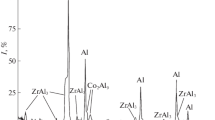Abstract
A NUMBER of zinc-based alloys containing equiaxed particles of various stable and insoluble hard second phases were prepared as part of an investigation into the high-temperature compression creep characteristics of dispersion-hardened materials1. It was found that the dispersed particles produced a substantial strengthening effect at temperatures above 0.60 of the absolute melting temperature of zinc. Room-temperature tensile tests were made in order to measure the expected loss in ductility of zinc caused by the hard particles. It was surprising to find, therefore, that most of the dispersed particles reduced the strength and increased the ductility of zinc. These results are briefly reviewed here.
Similar content being viewed by others
References
McCarthy, W. H., Ph.D. dissertation, Stanford Univ., California (1965).
Seitz, F., Adv. Phys., 1, 43 (1952).
Read, W. T., Dislocations in Crystals, 85 (McGraw-Hill Book Co., 1953).
Author information
Authors and Affiliations
Rights and permissions
About this article
Cite this article
MCCARTHY, W., SHYNE, J. & SHERBY, O. Dispersion-softened Zinc Alloys. Nature 208, 579–580 (1965). https://doi.org/10.1038/208579b0
Issue Date:
DOI: https://doi.org/10.1038/208579b0
- Springer Nature Limited
This article is cited by
-
Superplasticity: A review
Journal of Materials Science (1970)
-
Superplasticity: A review
Journal of Materials Science (1970)
-
The effect of inclusions on the stress distribution in solids
Journal of Materials Science (1968)





